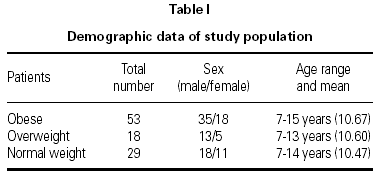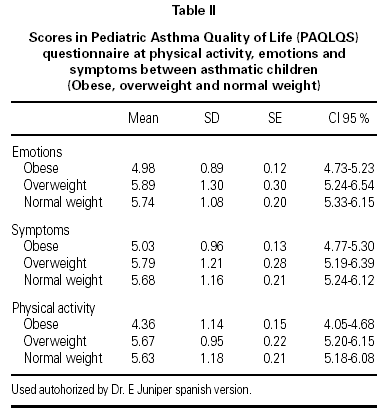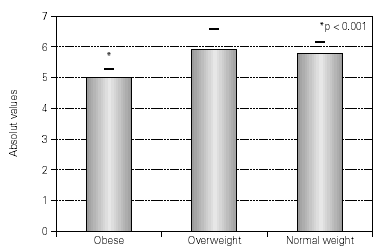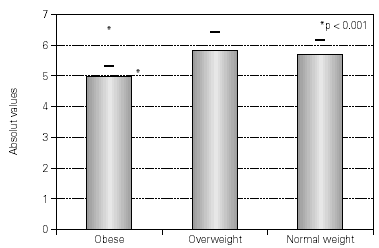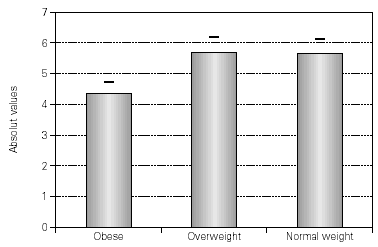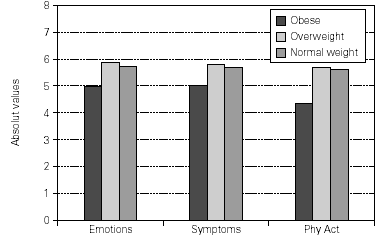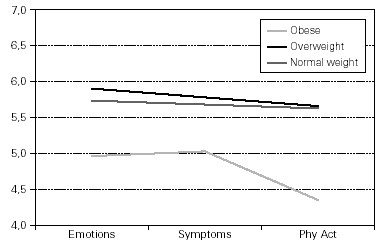INTRODUCTION
The prevalence of asthma has increased in recent decades and is now considered the most common chronic disease in pediatric age1. For many years, the improvement of symptoms and the normal pulmonary function test were the main targets of treatment. In the Quality of Life questionnaires published until recent, the aim was to correlate daily life activities with clinical evolution2-5.
Additional to the increase incidence of asthma, obesity in asthmatic children has also been on the increase, causing exacerbation of the respiratory symptoms as dyspnea, cough and wheezing6-9.
Several studies have been performed to determine if obesity could be a risk factor for asthma. However, the relation has not been evident in all of the cases10. Wilson et al11 suggest a purely casual relation, considering that both, asthma and obesity, are common conditions that could independently be on the increase; one condition not necessarily being the cause of the other. Dyspnea and wheezing could be attributed to several causes in obese individuals or in overweight persons; for example, could be caused by an increase in the breathing effort or by lack of physical training in patients that limit their activities because of an uncontrolled asthma. Little or none physical activity could be responsible for causing obesity or overweight.
Severe obesity (body mass index between 35 and 39 kg/mg2 in adults) causes extra thoracic obstruction because of an increase in adipose tissue12. The weight increase provokes a decrease in the size of the airway because of restriction of the thoracic wall13. Obstructive sleep apnea is also incremented in these patients14. Commonly alterations such as the previously mentioned sleep apnea or hypoventilation are frequent among obese patients15.
In animal models obesity causes histological changes in the lungs, but the relevance of these studies in humans, particularly through body mass index are uncertain16.
Habitually, the asthmatic patients that afterward becomes obese, presents a more bumpy evolution17. Only one epidemiological study, demonstrated that obesity increased the possibility of becoming asthmatic. In this case it was obvious that symptoms in the individual if not because obesity, could have been consider subclinical18. Obesity also increases the risk of suffering gastroesophageal reflux that could be a trigger for a latent asthmatic condition19 or produce obstructive sleep apnea as a result of the reflux, making it more difficult to manage with the consequent concealment of the previously mentioned asthmatic symptoms11,20,21.
If the physician wants to have a full vision of the health condition of the patient, he/she should take into consideration these aggravating factors and measure them through clinic conventional indexes and through daily life activities22. Pediatricians and Allergy Doctors, recognize the importance of making a Quality of Life Questionnaire as part of the patient's follow-up. The questionnaire could become an additional valuable tool to evaluate the response to the medical or dietary treatment or to both.
Scientific evidence leads to evaluation of pulmonary function test in response to bronchodilators or the measurement of non specific challenges for hyperreactivity and the combination of all, in order to diagnose and identify the person suffering from asthma11. However; "quality of life" generally has a different meaning for each person. That makes it difficult to adopt a definition that will be accepted by all. But investigators have agreed that many factors, such as spirituality, finance and health (and in children, family environment and the support of their parents) contribute to the quality of life23. Schipper et al24 propose a definition that we find adequate; one that states that quality of life is the result of the functional effects of a disease and of the therapy given to a patient and how the patient notices them.
Generally there are two types of health-related Quality of Life Questionnaires: generics and specifics for a certain condition. Both compile data of the fundamental dimensions of the quality of life. Generic questionnaires has been designed to by applied to patients independent of their health condition, age and type of disease. In this group we find the SIP (Sickness Impact Profile)25, SF 36 (Medical Outcomes Survey Short Form 36)26 and NHP (Nottingham Health Profile)27. The specific questionnaires includes among others, the "RQLQ" (Rhinoconjunctivitis Quality of Life Questionnaire Self-Administered. Mc Master University),(28) that measures quality of life in patients with rhinoconjunctivitis or the AQLQ (Asthma Quality of Life Questionnaire) for either Marks29,30 or Juniper5.
The purpose of using the questionnaire in pediatric patients was to analyze the asthma symptoms (dyspnea, cough or wheezing) that might interfere with the patient's daily life activities at physical, social, educational and emotional level. The Pediatric Asthma Quality of Life (PAQLQS) questionnaire prepared by Doctor Juniper5 is a standardized and validated tool that can be filled by pediatric patients in the range of 7 to 17 years of age. It contains 23 questions that cover 3 areas: symptoms, limitations of activities and emotional level. Each area has a specific number of questions. The validation of the questionnaire makes it possible to assign the same importance and weight to each area when making the general evaluation. The evaluation takes into account the patient's limitation of physical activities (five questions) to see how asthma produced an effect on the activities appropriate to their age group (physical activities with friends or pets); if the patient could, or could not follow their peer's rhythm or if they had breathing difficulties. In the evaluation of symptoms, ten questions are asked about episodes of coughing, tiredness, wheezing, chest tightness, dyspnea and waking up at night among others. At the emotional level, questions include pretexts, frustrations, preoccupations, anger, or ill temper caused by asthma.
Questions are marked in a scale from 1 to 7. One is maximum alteration (ALL THE TIME/EXTREMELY) and seven is no alteration (NEVER/NOTHING). The objective of the scale is to estimate how the patient feels with regard to his/her health when he/she is answering the questionnaire. In this questionnaire the patient's feelings, emotions, and physical activities are investigated during the week before coming to his/her check up. It serves also to obtain information about the changes in the quality of life of the patients since his/her last visit to the clinic and the subsequent response to the established treatment.
As to the evaluating properties of the questionnaire, it serves to detect any improvement or deterioration of patients, this allows to notice important changes in the quality of life, even with small samples of 40 patients or less2. Besides it is a standardized tool that has been validated to be used in Spanish31.
To verify how obesity and overweight have an impact in the quality of life, a survey was done using a standardized questionnaire validated for asthmatic patients, comparing the results of normal weight asthmatic patients, with those of obese and overweight asthmatic patients.
Considering the above, and the absence of quality life studies in obese asthmatic children we set out to determine and compare the quality of life of asthmatic patients obese, overweight or normal weighted patients. Our hypothesis was to prove that in the group of asthmatic obese and overweight patients there was a deterioration of the quality of life as compared to that of normal weight asthmatic patients.
MATERIALS AND METHODS
A prospective, observational and comparative study of surveys performed with an initial sample of 100 asthmatic children recruited from the Asthma, Allergy and Immunology clinic at Hospital Infantil de Mexico Federico Gomez.
Boys and girls between 7 to 17 years of age with diagnosis of intermittent asthma and mild persistent asthma, as per GINA 200232 were included. Obesity, overweight or normal weight as per Cole and collaborators33 who made known at world level, the standard definition for overweight and obesity in children accepted by the World Health Organization. The measuring instrument was the Questionnaire of Quality of Life PAQLQ(S) in which the 23 variables included were marked in 3 levels as mentioned above: symptoms, limitations of activities and emotional state.
Data analysis
Questionnaires were entered in an electronic database. The study data was analyzed with central tendency measures, standard deviation (SD), 95 % confidence intervals (CI95 %), standard error (SE) and frequency. They were analyzed with ANOVA using the program SPSS statistical software program version 10 (SPSS Inc. Chicago, IL) for all analyses.
RESULTS
The final study will be of 317 patients in each group of obese, overweight and normal weight; with a size of the sample established to comply 95 % potency.
We are presenting preliminaries of the first 100 patients evaluated stratified in 3 groups, according to their body mass index in obese (N = 53), overweight (N = 18) and normal weight (N = 29).
Out of 100 patients in the study 66 % were males and 34 % females, with a ratio of 1.5: 1, with a mean age of 10.4 years ± 2.12 (standard deviation) (table I). There were no significant differences of the three evaluated groups in sex, age and height. When the inter group results were analyzed, emotional state, physical limitations and symptoms, no differences were found (p > 0.05).
Added together (table II) the questions that evaluated the emotional state in obese children had a mean value of 4.98 ± 0.89 (SD), SE of 0.12 and a CI95 % of 4.73-5.23. Those overweight had 5.89 ± 1.30 (SD), SE of 0.30 and a CI95 % of 5.24-6.54. Those with normal weight, had 5.74 ± 1.08 (SD), SE 0.20 and a CI95 % of 5.33-6.15. The patients with overweight and normal weight had alpha values > 0.05 (fig. 1).
Figure 1.--Difference of mean values and confidence intervals over emotional factor between asthmatic children: obese, overweight and normal weight.
As to the evaluation of symptoms, the obese children had a mean value of 5.03 ± 0.96 (SD), SE of 0.13 and a CI 95 % of 4.77-5.30. Those with overweight, had 5.79 ± 1.21 (SD), SE of 0.28 and a CI95 % of 5.19-6.39. Those with normal weight, had 5.68 ± 1.16 (SD), SE of 0.21 and a CI 95 % of 5.24-6.12 (fig. 2).
Figure 2.--Difference of mean values and confidence intervals over symptoms between asthmatic children: obese, overweight and normal weight.
In the area of physical activity limitation, the obese obtained a mean value of 4.36 ± 1.14 (SD), SE 0.15 and a CI95 % of 4.05-4.68. Those with overweight obtained 5.67 ± 0.95 (SD), SE of 0.22 and a CI95 % of 5.20-6.15. Those with normal weight had 5.63 ± 1.18 (SD), SE 0.21 and a CI 95 % of 5.18-6.08. It was observed that the patients with overweight and normal weight had increased mean values than the obese indicating less limitation at this level (fig. 3).
Figure 3.--Difference of mean values and confidence intervals over physical activity between asthmatic children: obese, overweight and normal weight.
Comparing the results at the 3 levels evaluated in the questionnaire (emotions, symptoms and limitation of activities) (fig. 4) only in the asthmatic obese group versus the normal weight asthmatic group significant difference were found (p < 0.000). The same was true for the group of obese versus overweight (p < 0.005). No differences were found when comparing normal weight asthmatics with overweight (p = 1). This suggests that when evaluating patients, through the Quality of Life Questionnaire, a discreet increase in weight over what is expected for the age group, does not necessarily implies a worsening of the symptoms, the emotional level or limitation of activities.
Figure 4.--Difference between mean values in the 3 groups of asthmatic children: obese, overweight and normal weight at emotional level (Em), symptoms (Symp) and physical activity (Ph Act).
DISCUSSION
It has been correlated that in obesity and overweight there is an increase in the sympathic tone and that this two entities jointly could be conditioned by the administration of medicines (corticosteroids) or the sedentary life that would cause weight gain in asthmatics patients34. On the other hand, some theories effectively associate asthma with obesity. The intervention of the cyclooxygenase-2 (COX-2) has been mentioned in the development of asthma and obesity35. Visser and collaborators36 found in obese adults an increase in the reactive C protein that indirectly leads to the production of the pro inflammatory cytokine IL-6. The adipose tissue as well as macrophages of obese rats with leptin deficiency produces IL-637. Increased of IL-6 and COX-2 cause also and increase in production of prostaglandin E2 that at the same time stimulates humoral immunity and production of Th2 profile cytokines (IL-4, IL-5 and IL-13) that are associated with the inflammatory response in asthma16.
There are several reasons of why obesity per se could increase the risk of asthma if the functional consequences due to changes in the airway were sufficient to modify the behavior of the same (for example bronchial hyperreactivity)14. Alternatively; the anatomical changes could increment the presence of wheezing and dyspnea without altering the behavior of the airway. It has been reported that obese patients have symptoms that mimic those of asthmatic patients without the presence of hyperreactivity or possibility of atopy38.
Considering that the only scientific way to evaluate the quality of life is through a validated and standardized questionnaire, it is of the outmost importance to apply a questionnaire of Quality of Life in Pediatric Asthma that would include several aspects that would reflex the functioning of asthmatic patients in areas of importance to their well being. That of course includes physical activities as well as emotional issues. The pattern should be easy to reproduce under any circumstance and should also be versatile in order to detect any changes it may occur in the patient even if they are minimal5.
The obtained results show a statistic significance where obesity is related with a poorer quality of life in children with asthma. The overweight group did not show significant differences when compared with the normal weight group. Something that could account for the changes in this constant patter in the three levels measured (symptoms, limitations of physical activities and emotions) in this same group, could be the sample size. We had 29 in the normal weight group, 18 in the overweight group and 53 in the obese group. We could conclude as per our results, that the quality of life of our patients as observed through the Pediatric Asthma Quality of Life questionnaire (PAQLS) is more affected in obese asthmatic children than overweight or normal weight children (fig. 5). However, we must corroborate this tendency with an increased sample size and with new studies to demonstrate that a better quality of life could be obtained by weight control of these patients. At the same time, it is necessary to undergo prospective studies to evaluate directly, the pulmonary function test jointly with quality of life.
Figure 5.--Correlation of obtained results in study groups. The lesser score indicates the most affected quality of life.



